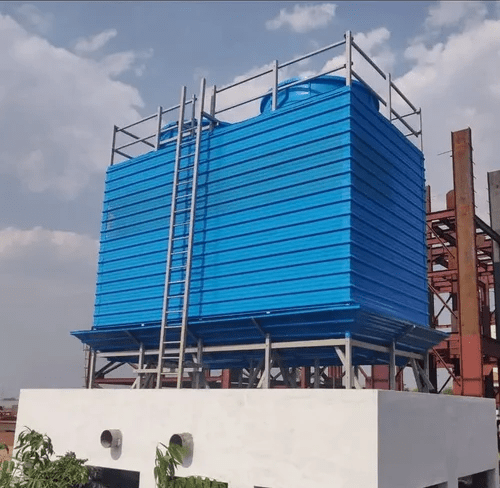An important process on most industries is the rejection of low-grade waste heat to the atmosphere by the use of water-cooling towers. The towers are filled with packing which provides a large surface area for the contact of warm water with atmospheric air.
Many chemical and food processes involve the rejection of latent heat in the condensing of steam or process vapors. Power generation using the steam cycle rejects more energy to the condensers than the electrical energy generated. Water is the common cooling medium and conservation requires that this is cooled and recirculated by the use of cooling towers.
A cooling tower is a direct contact heat exchanger in which warm water is discharged to the top of a packing system contained in a tower construction. The process is best explained in the context of a counter flow arrangement. The heat exchange process is of dual nature in that sensible heat is transferred by the temperature difference between the water and the air, and latent heat is transferred by evaporation of a small proportion of the water in to the air.
Cooling Tower Fundamentals
Heat Transfer: The basic principle of the cooling tower operation is that of evaporative condensation and exchange of sensible heat. The air and water mixture releases latent heat of vaporization which has a cooling effect on water by turning a certain amount of liquid into its gaseous state thereby releasing the latent heat of vaporization.
This is more effectively demonstrated by wetting the back of your hand with water and blowing on it. This effect is what happens inside the cooling tower. The air stream releases latent heat of vaporization thereby dropping the temperature of the water on your skin. The liquid changing to its vaporous state consumes heat which is taken from the water remaining, thus lowering its temperature.
There is a penalty involved, and that is loss of water which goes up to the cooling tower and is discharged into the atmosphere as hot moist vapor. Under normal operating conditions, this amounts to approximately 1.2% for each 10 deg F cooling range.
Sensible heat that changes temperature is also responsible for part of the cooling tower’s operation. When water is warmer that the air, there is a tendency for the air to cool the water.
The air then gets hotter as it gains the sensible heat of the water and the water is cooled as its sensible heat is transferred to the air. Approximately 25% of the sensible heat transfer occurs in the tower while the balance of the 75% cooling is due to the evaporative effect of latent heat of vaporization.
